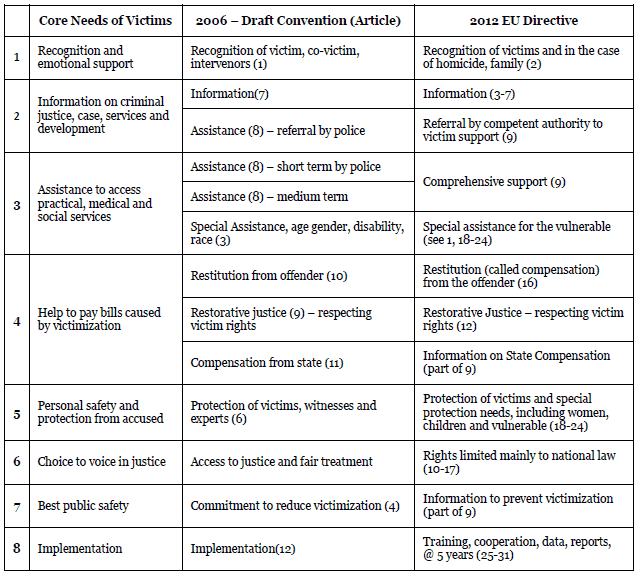On October 4th, 2012, the European Parliament and Council (effectively the European Union) made history by adopting a new directive to establish minimum standards for the rights, support and protection of victims of crime across 27 sovereign nations. These countries include such major nations as England and Wales, France, and Germany.
A Directive that will Advance Victim Rights for 500 Million People
The directive will provide rights for more than 500 million people, of whom the 75 million, who are victims of crime each year,, will be the ones to exercise those rights. (Rates of victimization are moderate in Europe. So only 15% of the 500 million people living in the EU will be victims of crime in a year.)
The minimum standards are impressive and should be the envy of victims of crime throughout the world. The 30 articles of the Directive commit 27 governments to providing information, support and assistance to all victims of crime and also ensure that support and rights will be provided across national borders. The articles provide for participation in criminal proceedings, such as the right to review a decision not to prosecute an offender. They provide for special protections, particularly for women, children and vulnerable victims. They provide for restorative justice where the victims interests will be respected.
The standards are not just more political wishful thinking. They have teeth to get them implemented. Articles include actions on training, sharing of best practices, cooperation between countries, and data designed to strengthen implementation.
The table below shows the general areas in which the articles will require governments to meet the minimal standards. This table is organized around the analysis in the book Rights for Victims of Crime of the core needs of victims (see chapters One and Two). The second column shows the sections for a comprehensive law to meet the needs of victims (see appendix). The table gives the numbers of the sections in the Directive and shows that the directive is impressively comprehensive.

There are several innovations in the Directive that are inspiring for other nations outside Europe. The Directive supports one stop shops for the delivery of support and assistance. The special protections cover victims of crime, not often covered, such as human trafficking and terrorism.
The directive includes a commitment to evaluate the extent to which its implementation will have achieved its goals of supporting and protecting victims – every five years. The data and the evaluation will have a special focus on Articles 8 and 9 which provide for universal referral by the police or other competent authority to universally available support and assistance services for victims of crime. Another focus is on Article 23 which provides for specific protections to victims of crime, including those impacted by gender and child related crime, terrorism and human trafficking.
Some Reflections on Victim Needs Still Not Met in the Minimum Standards
The directive sets a minimum standard which is important as a minimum. But to meet needs, we must advance to practices that some countries are demonstrating as feasible and successful. So several affluent democracies already provide services, rights and protections that are more extensive and closer to international standards and best practices. Within Europe, the Directive does not take anything away from victims in these countries that are more advanced than the minimum standard.
For instance, the Directive has not changed the provisions for standing for victims in criminal trials. France provides victims with standing in the criminal court through their own lawyer who may be paid out of legal aid – somewhat similar to those adopted also by the International Criminal Court. Countries such as England that are not as advanced on this point will continue with much more limited provision which are more similar to Canada or the USA (see chapter 6).
There are few weaknesses in the directive. It includes a common disclaimer that nothing will prejudice the rights of offenders and so does not deal with issues where basic rights of offenders and victims are in conflict (see chapter 8). The provisions for restitution (called compensation in the Directive) fall far short of what is needed for restitution to be ordered as often as it could be (see chapter 6). It does not include provisions to reduce victimization and so sidesteps the considerable knowledge we have to meet the number one right of victims – not to be victims (see chapter 7 and recent posts).
Let´s hope that the evaluation shows that the basic needs of 75 million victims are being met. For more information on the impressive achievement see minimum standards and rights for 500 million people.

